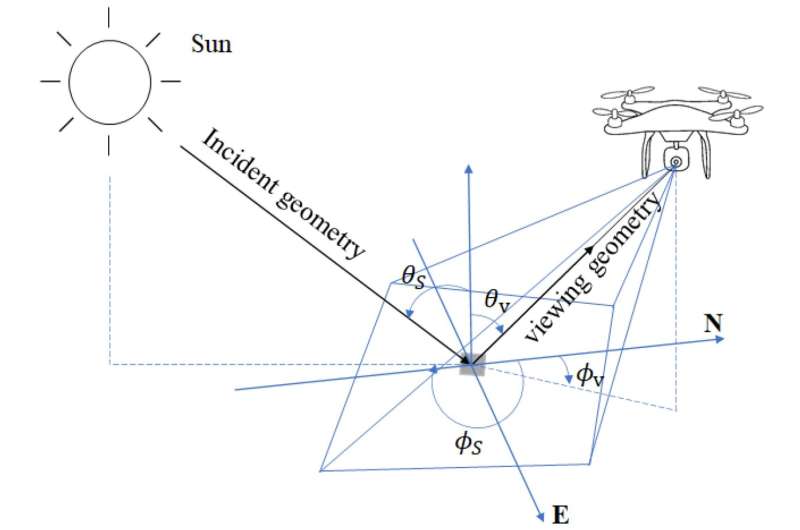Bidirectional reflectivity measurements for ground-based objects

Measuring bidirectional reflectivity of ground-based objects has long posed a challenging task, hampered by limitations in both ground-based and satellite-based observations from multiple angles. However, in recent years, unmanned aerial vehicles (UAVs) have emerged as a valuable remote sensing solution, providing convenience and cost-effectiveness while enabling multi-view observations.
A recent study employed polygonal flight paths along the hemisphere to measure Bidirectional Reflectance Distribution Function (BRDF) for ground-based objects, even at large zenith angles and all azimuth angles. The study was published in Remote Sensing on Oct. 18, 2023.
Conducted by a research team from the Aerospace Information Research Institute (AIR) under the Chinese Academy of Sciences (CAS) and Tianjin Normal University, this study utilized the principles of photogrammetry’s aerial triangulation to restore accurate observation angles and construct the geometric structure of the “sun–object–view” relationship. The aim was to address the challenges posed by the intricate measurement of bidirectional reflectivity for ground-based objects, a key factor in understanding their reflective properties.
The study also involved the comparison and evaluation of three BRDF models at the UAV scale. These models included M_Walthall, RPV, and RTLSR, with the focus on assessing their fitting quality, shape structure, and reflectance errors to determine their inversion performance.
The results of the study revealed that the RPV model demonstrated superior inversion performance, followed closely by M_Walthall. However, the RTLST model performed less effectively. Notably, the M_Walthall model excelled in capturing the reflective characteristics of smooth terrain objects, while RPV proved highly applicable to various types of rough terrain objects. This multi-scale applicability was observed not only for UAVs but also for satellite-based observations.
These findings are poised to significantly impact the study of ground-based objects’ bidirectional reflectivity properties. They provide an essential technical procedure for exploring and understanding the in-plane reflection properties of various ground-based objects. As UAV technology continues to advance, the innovative techniques and insights from this research are set to drive further progress in the field of remote sensing and environmental monitoring.
More information:
Hongtao Cao et al, The Method of Multi-Angle Remote Sensing Observation Based on Unmanned Aerial Vehicles and the Validation of BRDF, Remote Sensing (2023). DOI: 10.3390/rs15205000
Citation:
Bidirectional reflectivity measurements for ground-based objects (2023, October 27)
retrieved 29 October 2023
from https://techxplore.com/news/2023-10-bidirectional-ground-based.html
This document is subject to copyright. Apart from any fair dealing for the purpose of private study or research, no
part may be reproduced without the written permission. The content is provided for information purposes only.
For all the latest Technology News Click Here
For the latest news and updates, follow us on Google News.
